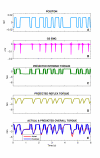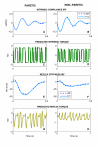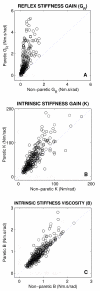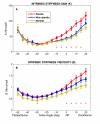Muscle and reflex changes with varying joint angle in hemiparetic stroke
- PMID: 18304313
- PMCID: PMC2292203
- DOI: 10.1186/1743-0003-5-6
Muscle and reflex changes with varying joint angle in hemiparetic stroke
Abstract
Background: Despite intensive investigation, the origins of the neuromuscular abnormalities associated with spasticity are not well understood. In particular, the mechanical properties induced by stretch reflex activity have been especially difficult to study because of a lack of accurate tools separating reflex torque from torque generated by musculo-tendinous structures. The present study addresses this deficit by characterizing the contribution of neural and muscular components to the abnormally high stiffness of the spastic joint.
Methods: Using system identification techniques, we characterized the neuromuscular abnormalities associated with spasticity of ankle muscles in chronic hemiparetic stroke survivors. In particular, we systematically tracked changes in muscle mechanical properties and in stretch reflex activity during changes in ankle joint angle. Modulation of mechanical properties was assessed by applying perturbations at different initial angles, over the entire range of motion (ROM). Experiments were performed on both paretic and non-paretic sides of stroke survivors, and in healthy controls.
Results: Both reflex and intrinsic muscle stiffnesses were significantly greater in the spastic/paretic ankle than on the non-paretic side, and these changes were strongly position dependent. The major reflex contributions were observed over the central portion of the angular range, while the intrinsic contributions were most pronounced with the ankle in the dorsiflexed position.
Conclusion: In spastic ankle muscles, the abnormalities in intrinsic and reflex components of joint torque varied systematically with changing position over the full angular range of motion, indicating that clinical perceptions of increased tone may have quite different origins depending upon the angle where the tests are initiated.Furthermore, reflex stiffness was considerably larger in the non-paretic limb of stroke patients than in healthy control subjects, suggesting that the non-paretic limb may not be a suitable control for studying neuromuscular properties of the ankle joint. Our findings will help elucidate the origins of the neuromuscular abnormalities associated with stroke-induced spasticity.
Figures








Similar articles
-
The tonic stretch reflex and spastic hypertonia after spinal cord injury.Exp Brain Res. 2006 Sep;174(2):386-96. doi: 10.1007/s00221-006-0478-7. Epub 2006 May 6. Exp Brain Res. 2006. PMID: 16680428
-
Comparison of neuromuscular abnormalities between upper and lower extremities in hemiparetic stroke.Conf Proc IEEE Eng Med Biol Soc. 2006;2006:303-6. doi: 10.1109/IEMBS.2006.260530. Conf Proc IEEE Eng Med Biol Soc. 2006. PMID: 17946813
-
Deficits in the coordination of agonist and antagonist muscles in stroke patients: implications for normal motor control.Brain Res. 2000 Jan 24;853(2):352-69. doi: 10.1016/s0006-8993(99)02298-2. Brain Res. 2000. PMID: 10640634 Clinical Trial.
-
[Clinical treatment of spasticity--spastic movement disorders].Nervenarzt. 2013 Dec;84(12):1508-11. doi: 10.1007/s00115-013-3933-2. Nervenarzt. 2013. PMID: 24271110 Review. German.
-
The gap between clinical gaze and systematic assessment of movement disorders after stroke.J Neuroeng Rehabil. 2012 Aug 27;9:61. doi: 10.1186/1743-0003-9-61. J Neuroeng Rehabil. 2012. PMID: 22925463 Free PMC article. Review.
Cited by
-
Estimates of acausal joint impedance models.IEEE Trans Biomed Eng. 2012 Oct;59(10):2913-21. doi: 10.1109/TBME.2012.2213339. Epub 2012 Aug 15. IEEE Trans Biomed Eng. 2012. PMID: 22907963 Free PMC article.
-
Immediate effect of transcranial direct current stimulation combined with functional electrical stimulation on activity of the tibialis anterior muscle and balance of individuals with hemiparesis stemming from a stroke.J Phys Ther Sci. 2017 Dec;29(12):2138-2146. doi: 10.1589/jpts.29.2138. Epub 2017 Dec 7. J Phys Ther Sci. 2017. PMID: 29643591 Free PMC article.
-
Stroke survivors talk while doing: development of a therapeutic framework for continued rehabilitation of hand function post stroke.J Hand Ther. 2013 Apr-Jun;26(2):124-30; quiz 131. doi: 10.1016/j.jht.2012.08.002. Epub 2012 Oct 13. J Hand Ther. 2013. PMID: 23073514 Free PMC article.
-
The effect of fascial manipulation therapy on lower limb spasticity and ankle clonus in stroke patients.Eur J Transl Myol. 2024 Jul 3;34(3):12172. doi: 10.4081/ejtm.2024.12172. Eur J Transl Myol. 2024. PMID: 38958224 Free PMC article.
-
Neuromechanical control of impact absorption during induced lower limb loading in individuals post-stroke.Sci Rep. 2022 Nov 9;12(1):19104. doi: 10.1038/s41598-022-21271-8. Sci Rep. 2022. PMID: 36352032 Free PMC article.
References
Publication types
MeSH terms
LinkOut - more resources
Full Text Sources
Medical

